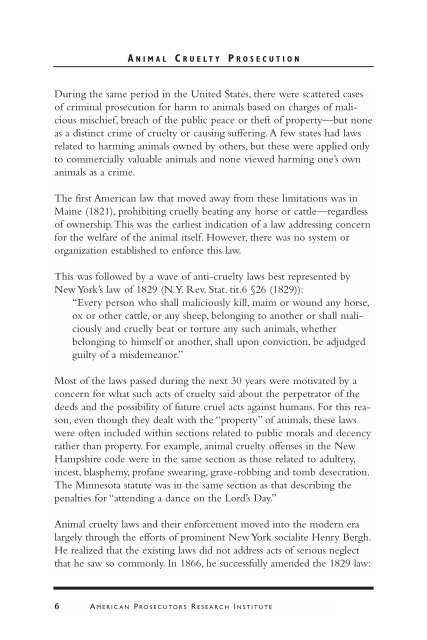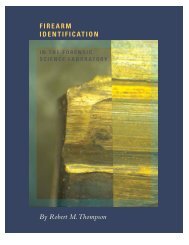Animal Cruelty Prosecution Animal Cruelty Prosecution
Animal Cruelty Prosecution Animal Cruelty Prosecution
Animal Cruelty Prosecution Animal Cruelty Prosecution
Create successful ePaper yourself
Turn your PDF publications into a flip-book with our unique Google optimized e-Paper software.
A NIMAL C RUELTY P R OSECUTION<br />
During the same period in the United States, there were scattered cases<br />
of criminal prosecution for harm to animals based on charges of malicious<br />
mischief, breach of the public peace or theft of property—but none<br />
as a distinct crime of cruelty or causing suffering. A few states had laws<br />
related to harming animals owned by others, but these were applied only<br />
to commercially valuable animals and none viewed harming one’s own<br />
animals as a crime.<br />
The first American law that moved away from these limitations was in<br />
Maine (1821), prohibiting cruelly beating any horse or cattle—regardless<br />
of ownership.This was the earliest indication of a law addressing concern<br />
for the welfare of the animal itself. However, there was no system or<br />
organization established to enforce this law.<br />
This was followed by a wave of anti-cruelty laws best represented by<br />
New York’s law of 1829 (N.Y. Rev. Stat. tit.6 §26 (1829)):<br />
“Every person who shall maliciously kill, maim or wound any horse,<br />
ox or other cattle, or any sheep, belonging to another or shall maliciously<br />
and cruelly beat or torture any such animals, whether<br />
belonging to himself or another, shall upon conviction, be adjudged<br />
guilty of a misdemeanor.”<br />
Most of the laws passed during the next 30 years were motivated by a<br />
concern for what such acts of cruelty said about the perpetrator of the<br />
deeds and the possibility of future cruel acts against humans. For this reason,<br />
even though they dealt with the “property” of animals, these laws<br />
were often included within sections related to public morals and decency<br />
rather than property. For example, animal cruelty offenses in the New<br />
Hampshire code were in the same section as those related to adultery,<br />
incest, blasphemy, profane swearing, grave-robbing and tomb desecration.<br />
The Minnesota statute was in the same section as that describing the<br />
penalties for “attending a dance on the Lord’s Day.”<br />
<strong>Animal</strong> cruelty laws and their enforcement moved into the modern era<br />
largely through the efforts of prominent New York socialite Henry Bergh.<br />
He realized that the existing laws did not address acts of serious neglect<br />
that he saw so commonly. In 1866, he successfully amended the 1829 law:<br />
6 A MERICAN P R OSECUTORS R ESEARCH I NSTITUTE







